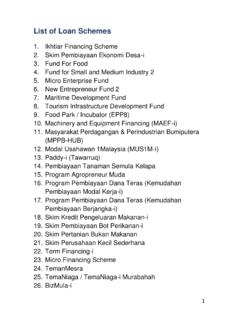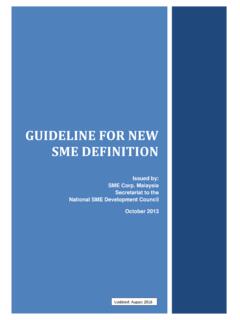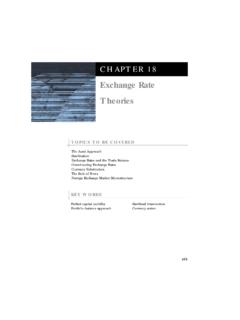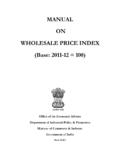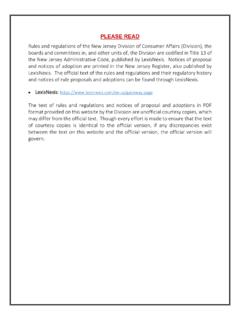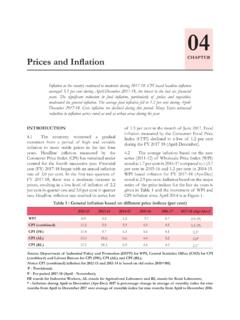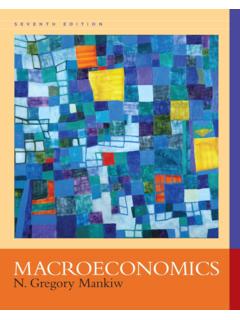Transcription of SME ANNUAL REPORT 2016/17 - SME Corporation Malaysia
1 SME ANNUAL REPORT 2016/17 CHAPTER 1 THE MALAYSIAN ECONOMYC hapter 1: The Malaysian EconomyChapter 2: SME Developments and Outlook006014 Section Ieconomic assessmentSME ANNUAL REPORT 2016/17 midst continuing uncertainties in the world economy, the global growth rate for 2016 was the lowest since the Global Financial Crisis. However, against a backdrop of external and domestic headwinds, the Malaysian economy registered a commendable real Gross Domestic Product (GDP) growth of in 2016 (2015: ). The moderate growth was supported by domestic demand mainly by private sector spending. Following the strong growth in the first half of 2017 at , Malaysia s GDP growth is expected to expand by more than in 2017, higher than the earlier official growth projection of between - This growth will also be supported by a more entrenched global recovery and positive spillovers to the domestic demand will continue to be the key driver of growth, sustained primarily by private sector spending.
2 The Government s commitment to fiscal consolidation, continued implementation of key infrastructure projects, sound macroeconomic fundamentals and expectations of recovery in export growth in-line with the improvement in global growth will be key elements to enable the country to move towards a sustainable growth Malaysian EconomyAconsolidation, continued implementation of key infrastructure projects, sound macroeconomic fundamentals and expectations of recovery in export growth in-line with the improvement in global growth will be key elements to enable the country to move towards a sustainable growth 1 THE MALAYSIAN ECONOMY20152016p1H 2017p2017eAnnual change (%)Domestic Demand Private Sector Expenditure Consumption Investment Public Sector Expenditure Consumption Investment exports of goods and services Exports ~ the challenging economic environment, the Malaysian economy continued to record a commendable growth of in 2016 (2015: ), largely supported by continued expansion in domestic demand.
3 Private consumption was the main driver that anchored economic performance in 2016. Wage and employment growth as well as Government measures have supported the domestic market while the increase in minimum wage in July 2016 and civil servants salary in the second half of the year affected a higher salary growth. The Government had also introduced measures to support household spending in the form of a reduction in employees Employees Provident Fund (EPF) contributions (from 11% to 8% in the period of March 2016 to December 2017), higher Bantuan Rakyat 1 Malaysia (BR1M) payouts and special tax relief of RM2,000 to individual taxpayers. Private investment moderated further to in 2016 (2015: ) as firms adjusted to the challenging market environment where profitability and business sentiments remained weak. Public consumption growth moderated to (2015: ) due to lower spending on supplies and services following the Government s adoption of expenditure rationalisation in early 2016 as low crude oil prices led to lower petroleum-related revenue.
4 Public investment continued to support economic growth mainly from developing transportation infrastructure, enhancing industrial development, improving public utilities and accelerating the development of the agriculture and rural : Real GDP by Expenditure (at 2010 prices)PERFORMANCE IN 20161 Excluding stocks, p: preliminary, e: estimate based on BNM ANNUAL REPORT 2016 Source: Department of Statistics, Malaysia17 SME ANNUAL REPORT 2016/17 On the supply side, all major economic sectors, except the agriculture sector, recorded an expansion in 2016. The services sector grew by in 2016 (2015: ) owing to sustained demand in the consumer -related sectors while other sectors expanded more moderately. The agriculture sector contracted due to a decline in crude palm oil (CPO) production as yields were affected by the El Ni o weather labour market conditions generally remained stable, the unemployment rate however edged higher to in 2016 (2015: ) due to slower job creation as employers adopted a cautious stance and refrained themselves from expanding their workforce too quickly amid more moderate economic inflation was maintained at in 2016 (2015: ).
5 The inflation rate was led by a series of adjustments in administered prices such as reduction in electricity rebates and cooking oil as well as higher fresh food prices due to El Ni o weather phenomenon. Headline inflation was also more volatile throughout the year due to external global factors. 201520162017 ANNUAL change (%)InflationConsumer Price Index (2010 = 100)Producer Price Index (2010 = 100) ~ ~ : Real GDP by Key Economic Activity (at 2010 prices)Table : Inflation and Unemployment Ratep: preliminary, e: estimate based on BNM ANNUAL REPORT 2016 Source: Department of Statistics, Malaysiap: preliminary, e: estimate based on BNM ANNUAL REPORT 2016 Source: Department of Statistics, Malaysia 201520161H 20172017 ANNUAL change (%)AgricultureMining & QuarryingManufacturingConstruction ~ 1 THE MALAYSIAN ECONOMYM alaysia s external sector remained resilient in 2016 despite a recent sharp decline in commodity prices. Malaysia s trade balance remained strong in surplus although it has narrowed.
6 The narrowing of the current account surplus reflected the lower trade surplus and persistent structural deficits in the services and income accounts. This highlights the importance of advancing structural reform measures in order to promote trade and investment diversification as well as competitiveness. Table : Balance of Paymentsp: preliminary, e: estimate based on BNM ANNUAL REPORT 2016 Source: Department of Statistics, Malaysia 201520162017RM billionCurrent Account % of GNIG oods Export of Goods Gross Export (% ANNUAL change) Import of Goods Gross Import (% ANNUAL change)ServicesPrimary IncomeSecondary ~ Account Investment Assets LiabilitiesPortfolio Investment Assets LiabilitiesFinancial DerivativesOther Errors and Balance (surplus + / deficit -)Net International Reserves BNMNet International Reserves of BNM (USD billion)Reserves as Months of Retained Imports ANNUAL REPORT 2016/17 In 2017, global economic activities are expected to expand at a faster pace.
7 This will be supported by an expansion in domestic demand in the advanced and emerging market economies as well as expectations of a recovery in trade activities in the emerging regions. According to the International Monetary Fund (IMF) latest World Economic Outlook (WEO) Update, July 2017, the projected pick up in global growth remains on track with the cyclical recovery continues. The IMF upgraded its forecasts for Japan and Europe s main economies such as Germany, France, Italy and Spain as well as in large emerging and developing economies such a Brazil, China and Mexico, reflecting a stronger than expected outturn in the first quarter of 2017. High-frequency indicators for the second quarter of 2017 also provide signs of continued strengthening of global activity. Specifically, the global trade in 2017 is projected higher than 2015 and 2016 rates. World growth is expected to rise from in 2016 to in 2017 and in 2018, maintaining its forecast from April 2017 FOR 2017 Table : IMF World Economic Outlook (WEO) Update, July 2017p: preliminary, e: estimate, f: forecast* China, India, Indonesia, Malaysia , Philippines, Thailand & Vietnam** Indonesia, Malaysia , Philippines, Thailand & VietnamSource.
8 IMF World Economic Outlook Update, July 2017 201620172018 World Advanced United States of Euro United Emerging and Developing Emerging and Developing Asia * ASEAN-5 ** Emerging and Developing Latin America and the Middle East, North Africa, Afghanistan and World Trade Volume (goods and services) 1 THE MALAYSIAN ECONOMYW hile risks around the global growth forecast appear broadly balanced in the near term, they remain tilted to the downside over the medium term. On the upside risk, the pickup in activity in the euro area, with buoyant market sentiment and reduced political risks, could be stronger and more durable than currently projected. On the downside, prolonged policy uncertainty or other shocks could trigger a correction in market valuations, especially for equities and an increase in volatility.
9 In turn, this could dampen spending and confidence more generally, especially in countries with high financial vulnerabilities. Lower commodity prices would further intensify macroeconomic strains and complicate adjustment needs in many commodity exporters. Other downside risks threatening the strength and durability of the recovery include non-economic factors, such as rising geopolitical tensions, domestic political discord and shocks arising from weak governance and , on the outlook for the Malaysian economy in 2017, domestic demand will continue to be the principal driver of growth, which will be sustained primarily by private sector activities. Private consumption is projected to grow by in 2017, sustained by a stable labour market, continued wage growth and increase in disposable income due to various Government measures including increasing the amount for BR1M cash transfers, reduction in employees contribution to EPF from 11% to 8% until December 2017 and special assistance to all civil servants (RM500) and retirees (RM250).
10 The anticipated higher commodity prices are also expected to support incomes, particularly for rural households. Tourism activities are expected to continue to increase with more tourist arrivals and spending from China and India, due to the eVisa programme as well as intensified promotions targeting specific sectors, such as medical, health and sports investment is projected to grow at a moderate pace of in 2017 as business sentiment remains cautious with some degree of uncertainty in the economy. Given this situation, activities will still be supported by higher capital expenditure in export-oriented industries and implementation of on-going and new projects, mainly in the manufacturing and services sectors. Continued capacity expansion in domestic-oriented industries such as the telecommunications and real estate sub-sectors has continued to support the services sector. In line with the gradual improvement in global growth, investment in the manufacturing sector is expected to be driven particularly by export-oriented industries such as the electrical & electronics and resource-based the Government s continuing commitment to fiscal consolidation, public consumption growth is projected to record a marginal contraction of in 2017.


